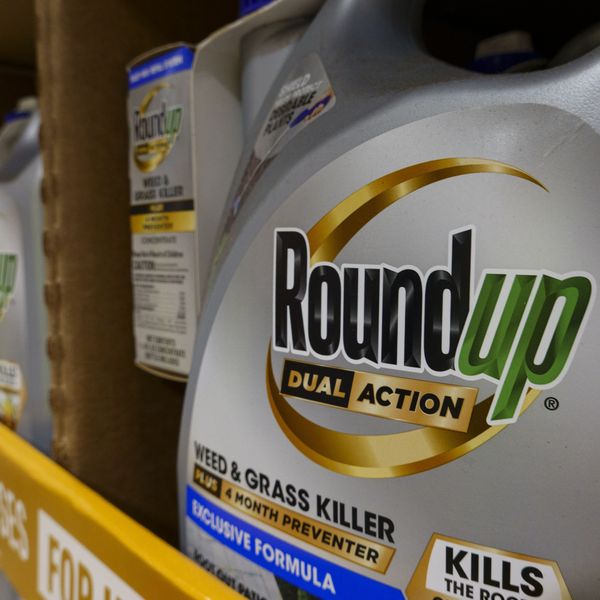Fears of Airborne Toxins Mount After Massive Port Explosions in China
Blasts occurred in an industrial area where toxic chemicals and gas were stored
This post may be updated.
At least 50 people are dead, and vast portions of the world's 10th-largest port are destroyed, after two huge explosions on Wednesday night rocked an industrial area where toxic chemicals and gas were stored in the northeast Chinese port city of Tianjin.
The blasts took place at around 11:30 pm local time at a warehouse belonging to Ruihai International Logistics, a transportation company that, according to its website, is involved in "cargo declaration, cargo transportation and warehouse storage of dangerous cargo."
CNN reports that "[a]s day broke Thursday, the extent of the damage was beginning to become clear. State media carried images of damaged buildings and parking lots full of rows of burned-out cars."
More than 700 people are injured, many from falling stones and shards of glass, and hospitals are struggling to cope with the number of casualties, according to the BBC. The blast is expected to force an estimated 6,000 people from their homes.
The cause of the explosions, which were said to be so large that they were seen by satellites in space, has yet to be determined. President Xi Jinping said in a statement carried by official media that those responsible should be "severely handled."
Reuters reports that city officials had met recently with companies to discuss tightening safety standards on the handling of dangerous chemicals. The Tianjin Administration of Work Safety posted a notice about the meeting with companies at the port on its website a week ago.
Time magazine adds that rescue operations have been suspended as teams scan the area for toxic chemicals and "fears of airborne toxins mount."
"With a blast like this, normally you would expect the transport [of particulate matter] to be along the wind gradient or contours, but a blast this big must push it beyond that in the opposite direction," Ravi Naidu, director of the Global Centre for Environmental Remediation at the University of Newcastle Australia, told Time. "Not just people but animals and other organisms would be exposed to certain chemicals."
And Greenpeace Asia's Beijing office said: "We are concerned that certain chemicals will continue to pose a risk to the residents of Tianjin. According to the Tianjin Tanggu Environmental Monitoring Station, hazardous chemicals [that may have been at the blast site] include sodium cyanide (NaCN), toluene diisocyanate (TDI) and calcium carbide (CaC2), all of which pose direct threats to human health on contact. NaCN in particular is highly toxic. Ca(C2) and TDI react violently with water and reactive chemicals, with risk of explosion. This will present a challenge for firefighting and, with rain forecast for tomorrow, is a major hazard."
Drone captures devastation of Tianjin cityDrone captures devastation of China's Tianjin city
Posted by BBC News on Thursday, August 13, 2015
An Urgent Message From Our Co-Founder
Dear Common Dreams reader, The U.S. is on a fast track to authoritarianism like nothing I've ever seen. Meanwhile, corporate news outlets are utterly capitulating to Trump, twisting their coverage to avoid drawing his ire while lining up to stuff cash in his pockets. That's why I believe that Common Dreams is doing the best and most consequential reporting that we've ever done. Our small but mighty team is a progressive reporting powerhouse, covering the news every day that the corporate media never will. Our mission has always been simple: To inform. To inspire. And to ignite change for the common good. Now here's the key piece that I want all our readers to understand: None of this would be possible without your financial support. That's not just some fundraising cliche. It's the absolute and literal truth. We don't accept corporate advertising and never will. We don't have a paywall because we don't think people should be blocked from critical news based on their ability to pay. Everything we do is funded by the donations of readers like you. Will you donate now to help power the nonprofit, independent reporting of Common Dreams? Thank you for being a vital member of our community. Together, we can keep independent journalism alive when it’s needed most. - Craig Brown, Co-founder |
This post may be updated.
At least 50 people are dead, and vast portions of the world's 10th-largest port are destroyed, after two huge explosions on Wednesday night rocked an industrial area where toxic chemicals and gas were stored in the northeast Chinese port city of Tianjin.
The blasts took place at around 11:30 pm local time at a warehouse belonging to Ruihai International Logistics, a transportation company that, according to its website, is involved in "cargo declaration, cargo transportation and warehouse storage of dangerous cargo."
CNN reports that "[a]s day broke Thursday, the extent of the damage was beginning to become clear. State media carried images of damaged buildings and parking lots full of rows of burned-out cars."
More than 700 people are injured, many from falling stones and shards of glass, and hospitals are struggling to cope with the number of casualties, according to the BBC. The blast is expected to force an estimated 6,000 people from their homes.
The cause of the explosions, which were said to be so large that they were seen by satellites in space, has yet to be determined. President Xi Jinping said in a statement carried by official media that those responsible should be "severely handled."
Reuters reports that city officials had met recently with companies to discuss tightening safety standards on the handling of dangerous chemicals. The Tianjin Administration of Work Safety posted a notice about the meeting with companies at the port on its website a week ago.
Time magazine adds that rescue operations have been suspended as teams scan the area for toxic chemicals and "fears of airborne toxins mount."
"With a blast like this, normally you would expect the transport [of particulate matter] to be along the wind gradient or contours, but a blast this big must push it beyond that in the opposite direction," Ravi Naidu, director of the Global Centre for Environmental Remediation at the University of Newcastle Australia, told Time. "Not just people but animals and other organisms would be exposed to certain chemicals."
And Greenpeace Asia's Beijing office said: "We are concerned that certain chemicals will continue to pose a risk to the residents of Tianjin. According to the Tianjin Tanggu Environmental Monitoring Station, hazardous chemicals [that may have been at the blast site] include sodium cyanide (NaCN), toluene diisocyanate (TDI) and calcium carbide (CaC2), all of which pose direct threats to human health on contact. NaCN in particular is highly toxic. Ca(C2) and TDI react violently with water and reactive chemicals, with risk of explosion. This will present a challenge for firefighting and, with rain forecast for tomorrow, is a major hazard."
Drone captures devastation of Tianjin cityDrone captures devastation of China's Tianjin city
Posted by BBC News on Thursday, August 13, 2015
This post may be updated.
At least 50 people are dead, and vast portions of the world's 10th-largest port are destroyed, after two huge explosions on Wednesday night rocked an industrial area where toxic chemicals and gas were stored in the northeast Chinese port city of Tianjin.
The blasts took place at around 11:30 pm local time at a warehouse belonging to Ruihai International Logistics, a transportation company that, according to its website, is involved in "cargo declaration, cargo transportation and warehouse storage of dangerous cargo."
CNN reports that "[a]s day broke Thursday, the extent of the damage was beginning to become clear. State media carried images of damaged buildings and parking lots full of rows of burned-out cars."
More than 700 people are injured, many from falling stones and shards of glass, and hospitals are struggling to cope with the number of casualties, according to the BBC. The blast is expected to force an estimated 6,000 people from their homes.
The cause of the explosions, which were said to be so large that they were seen by satellites in space, has yet to be determined. President Xi Jinping said in a statement carried by official media that those responsible should be "severely handled."
Reuters reports that city officials had met recently with companies to discuss tightening safety standards on the handling of dangerous chemicals. The Tianjin Administration of Work Safety posted a notice about the meeting with companies at the port on its website a week ago.
Time magazine adds that rescue operations have been suspended as teams scan the area for toxic chemicals and "fears of airborne toxins mount."
"With a blast like this, normally you would expect the transport [of particulate matter] to be along the wind gradient or contours, but a blast this big must push it beyond that in the opposite direction," Ravi Naidu, director of the Global Centre for Environmental Remediation at the University of Newcastle Australia, told Time. "Not just people but animals and other organisms would be exposed to certain chemicals."
And Greenpeace Asia's Beijing office said: "We are concerned that certain chemicals will continue to pose a risk to the residents of Tianjin. According to the Tianjin Tanggu Environmental Monitoring Station, hazardous chemicals [that may have been at the blast site] include sodium cyanide (NaCN), toluene diisocyanate (TDI) and calcium carbide (CaC2), all of which pose direct threats to human health on contact. NaCN in particular is highly toxic. Ca(C2) and TDI react violently with water and reactive chemicals, with risk of explosion. This will present a challenge for firefighting and, with rain forecast for tomorrow, is a major hazard."
Drone captures devastation of Tianjin cityDrone captures devastation of China's Tianjin city
Posted by BBC News on Thursday, August 13, 2015


